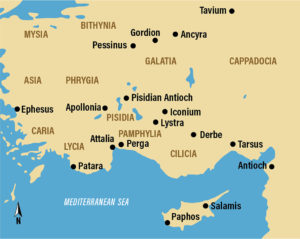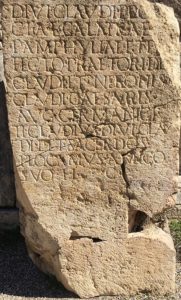Searching for Galatia’s borders in the first century
Megan Sauter May 12, 2022 0 Comments 28990 views


Who were the Galatians in the Bible? This map shows the regions of Anatolia during the first century C.E., when Paul would have traveled through the area. Recent archaeological discoveries suggest that the province of Galatia would have included the regions of Pisidia, Phrygia, Lycaonia, and Pamphylia at that time. Map: Biblical Archaeology Society.
Who were the Galatians in the Bible? The apostle Paul addressed one of his now-canonical letters to the “churches of Galatia” (Galatians 1:2), but where exactly were these churches located?
Galatia refers to a region in north central Turkey; Ankara, the capital of modern Turkey, was once a major Galatian city (Ancyra). The name of Galatia is derived from the 20,000 Gauls who settled in the region in 278 B.C.E. More than two centuries later, in 25 B.C.E., the area became a Roman province and was extended to the south. In Paul’s day, the new province included the regions of Pisidia, Phrygia, and Lycaonia. Scholars often refer to these new, southern regions as “south Galatia” and to geographic Galatia as “north Galatia.”
Yet recent archaeological discoveries suggest that Galatia extended even further south during the first century C.E.—meaning that the audience of Paul’s letter might be larger than earlier supposed.
In the Fall 2020 issue of Biblical Archaeology Review, Mark Wilson of the Asia Minor Research Center in Antalya, Turkey, examines the size of Galatia at the time that Paul visited and wrote his letter. As suggested by its title, “Galatia in Text, Geography, and Archaeology,” his article weighs all the available evidence for tracking down this province’s borders to determine the original audience of Paul’s letter to the Galatians.


Dated to the late 40s C.E., this Latin inscription from Perga mentions Galatia and Pamphylia as a joint Roman province and names Sextus Afranicus Burrus as its procurator. Photo: Mark Wilson.
The Book of Acts records Paul’s travels through “south Galatia,” including the cities of Pisidian Antioch, Iconium, Lystra, and Derbe (Acts 13–16). Paul also visited Perga and Attalia in the region of Pamphylia on the Mediterranean coast (Acts 13–14). Three recent archaeological discoveries suggest that these cities in Pamphylia were part of Galatia when Paul visited the region:
The Stadiasmus Patarensis, a road monument from the city of Patara in the region of Lycia, dates to 46 C.E. and lists Pamphylia as a bordering province. While some scholars had thought Lycia and Pamphylia were a joint province at this time, this road monument contradicts that theory and shows that Pamphylia and Lycia were not a joint province when Paul visited the area.
Further, two Latin inscriptions, excavated from the city of Perga in Pamphylia, name Galatia and Pamphylia as a joint province during the late 40s and early 50s C.E.
These inscriptions show that the province of Galatia stretched from central Anatolia to the Mediterranean Sea during Paul’s day. Wilson concludes that the audience of Galatians would have included cities in Pisidia, Phrygia, Lycaonia, and Pamphylia. Learn more about Galatia in Mark Wilson’s article “Galatia in Text, Geography, and Archaeology,” published in the Fall 2020 issue of Biblical Archaeology Review.
——————Subscribers: Read the full article “Galatia in Text, Geography, and Archaeology” by Mark Wilson in the Fall 2020 issue of Biblical Archaeology Review.
A version of this post first appeared in Bible History Daily in September, 2020
Our website, blog and email newsletter are a crucial part of Biblical Archaeology Society‘s nonprofit educational mission
This costs substantial money and resources, but we don’t charge a cent to you to cover any of those expenses.
If you’d like to help make it possible for us to continue Bible History Daily, BiblicalArchaeology.org, and our email newsletter please donate. Even $5 helps:
Read more in the Bas Library
Not a BAS Library or All-Access Member yet? Join today.
On the Road and on the Sea with St. Paul: Traveling conditions in the first century
by Jerome Murphy-O’Connor. In the Acts of the Apostles, we are told that Paul made three missionary journeys. In almost every introduction to the New Testament I have seen, the author discusses St. Paul’s journeys in terms of places and dates; his concern is to establish the location of the cities Paul visited and to fix the exact time he visited them. But when Paul himself speaks of his travels he emphasizes, not the “where” or the “when,” but the “how.”
After the Flood!: The drowning of an ancient Roman city by Jessica A. Meyerson. It was called one of the biggest archaeological finds in years: In late November 1999 Turkish and French archaeologists began excavating the ancient Roman city of Zeugma in southeastern Turkey. Within weeks, they’d unearthed two large villas containing over a dozen exquisite ancient Roman mosaics. Preliminary surveys revealed that hundreds of other villas lay buried just beneath the surface of the surrounding area. It’s a “second Pompeii,” crowed one local Turkish politician.
Paul’s Contradictions: Can they be resolved?
by John G. Gager. Was the apostle to the gentiles incapable of consistent thinking? Some recent Paul scholars have made precisely this claim. The Finnish exegete Heikki Räisänen, for example, has taken what I call a “contradictionist” view of Paul’s letters, insisting that “Paul’s thought on the law is full of…inconsistencies.”
Get more biblical Archaeology: Become a Member
The world of the Bible is knowable. We can learn about the society where the ancient Israelites, and later Jesus and the Apostles, lived through the modern discoveries that provide us clues.
Biblical Archaeology Review is the guide on that fascinating journey. Here is your ticket to join us as we discover more and more about the biblical world and its people.
Each issue of Biblical Archaeology Review features lavishly illustrated and easy-to-understand articles such as:
• Fascinating finds from the Hebrew Bible and New Testament periods
• The latest scholarship by the world’s greatest archaeologists and distinguished scholars
• Stunning color photographs, informative maps, and diagrams
• BAR’s unique departments such as First Person and Strata
• Reviews of the latest books on biblical archaeology
The BAS Digital Library includes:
• 45+ years of Biblical Archaeology Review
• 20+ years of Bible Review online, providing critical interpretations of biblical texts
• 8 years of Archaeology Odyssey online, exploring the ancient roots of the Western world in a scholarly and entertaining way,
• The New Encyclopedia of Archaeological Excavations in the Holy Land
• Video lectures from world-renowned experts.
• Full online access to 50+ curated Special Collections,
• Four highly acclaimed books, published in conjunction with the Smithsonian Institution: Aspects of Monotheism, Feminist Approaches to the Bible, The Rise of Ancient Israel and The Search for Jesus.
The All-Access membership pass is the way to get to know the Bible through biblical archaeology.


